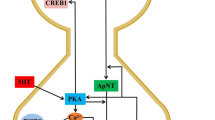Abstract
A mathematical model, called the Learning Gate Model (LGM), that describes phenomena responsible for biological synaptic plasticity, is presented. The functionality of the model are mainly based on the work of Kandel and colleagues on the most elementary forms of learning observed in the Aplysia Californica marine mollusc. In particular, emphasis is placed on the double temporal dynamics of synaptic plasticity and the temporal specificity of classical conditioning. By properly modeling the effect of the binding of Ca++ ions to the serotonin-sensitive adenylate cyclase enzyme, it is shown how a positively accelerated learning curve can be obtained for sensitization and classical conditioning. Phenomena of spontaneous recovery and second-order conditioning are reproduced through simulations. Mathematical analyses of the temporal trace of conditioned stimulus and of the Short-Term Memory steady state are also given.
Similar content being viewed by others
References
Bailey CH, Chen M (1983) Morphological basis of long-term habituation and sensitization in Aplysia. Science 220:91–93
Buonomano DV, Byrne JH (1990) Long-term synaptic changes produced by a cellular analog of classical conditioning in Aplysia. Science 249:420–423
Byrne JH, Eskin A, Scholz KP (1989) Neuronal mechanisms contributing to long-term sensitization in Aplysia. J Physiol 83:141–147
Carew TJ, Castellucci VF, Kandel ER (1971) An analysis of dishabituation and sensitization of the gill-withdrawal reflex in Aplysia. Int J Neurosci 2:79–98.
Carew TJ, Pinsker HM, Kandel ER (1972) Long-term habituation of a defensive withdrawal reflex in Aplysia. Science 175:451–454
Castellucci VF, Kandel ER (1976) Presynaptic facilitation as a mechanism for behavioral sensitization in Aplysia. Science 194:1176–1178
Gardner-Medwin AR (1989) Doubly modifiable synapses: a model of short and long term auto-associative memory. Proc R Soc Lond B 238:137–154
Gluck MA, Thompson RF (1987) Modeling the neural substrates of associative learning and memory: a computational approach. Psychol Rev 94:176–191
Grossberg S, Schmajuk NA (1989) Neural dynamics of adaptive timing and temporal discrimination during associative learning. Neural Networks 2:79–102
Groves PM, Thompson RF (1970) Habituation: a dual-process theory. Psychol Rev 77:419–450
Hawkins RD, Abrams TW, Carew TJ, Kandel ER (1983a) A cellular mechanism of classical conditioning in Aplysia: activity-dependent amplification of presynaptic facilitation. Science 219:400–405
Hawkins RD, Carew TJ, Kandel ER (1983b) Effects of interstimulus interval and contingency on classical conditioning in Aplysia. Soc Neurosci Abstr 9:168
Hawkins RD, Kandel ER (1984) Is there a cell-biological alphabet for simple forms of learning? Psychol Rev 91:375–391
Hebb DO (194) The organization of behavior. Wiley, New York
Kandel ER (1976) Cellular basis of behavior. Freeman, San Francisco
Kandel ER (1979) Small systems of neurons. Scie Am 241:66–76
Kandel ER, Abrams T, Bernier L, Carew TJ, Hawkins RD, Schwartz JA (1983) Classical conditioning and sensitization share aspects of the same molecular cascade in Aplysia. Cold Spring Harbor Symposium on Quantitative Biology, pp 821–830
Kandel Er, Schwartz JH (1982) Molecular biology of learning: modulation of transmitter release. Science 218:433–443
Klein M, Shapiro E, Kandel ER (1980) Synaptic plasticity and the modulation of the Ca++ current. J Exp Biol 89:117–157
Kohonen T (1984) Self-organization and associative memory. Springer, Berlin Heidelberg New York
Mackintosh NJ (1974) The psychology of animal learning. Academic Press, London
McNaughton BL (1983) Activity dependent modulation of hippocampal synaptic efficiency: some implications for memory processes. In Seifert W (ed) Neurobiology of the hippocampus. Academic Press, London, pp 233–252
Nazif FA, Byrne JH, Cleary LJ (1991) cAMP induces long-term morphological changes in sensory neurons of Aplysia. Brain Res 539:324–327
Pineda FJ (1988) Dynamics and architecture for neural computation. J Complex 4:216–245
Sutton RS, Barto AG (1981) Toward a modern theory of adaptive networks: expectation and prediction. Psychol Rev 88:135–170
Author information
Authors and Affiliations
Rights and permissions
About this article
Cite this article
Ciaccia, P., Maio, D. & Vacca, G.P. An analytical short- and long-term memory model of presynaptic plasticity. Biol. Cybern. 67, 335–345 (1992). https://doi.org/10.1007/BF02414889
Received:
Accepted:
Issue Date:
DOI: https://doi.org/10.1007/BF02414889




